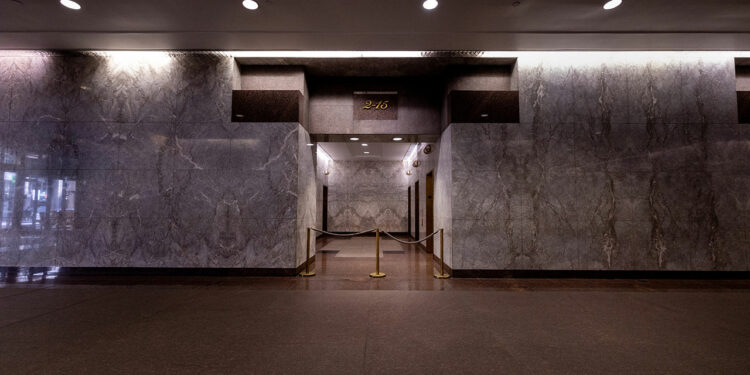Smith sees two factors as responsible for North American elevator costs: uncommonly stringent safety and accessibility codes, and a highly inefficient union monopoly.
The European Union enforces a uniform elevator safety code that is also the de facto world standard. Parts certified under this standard can be sold throughout the EU and anywhere else with harmonized regulations, including most industrialized nations besides North America and Japan.
North America, however, uses a standard maintained by the American Society of Mechanical Engineers and included in the International Building Code (which, despite its name, is little used elsewhere). North American standards are usually more demanding than EuropeŌĆÖs. For example, they require landing doors to withstand 2.5 times as much force and pass a generally more stringent fire safety test. To illustrate the results, Smith mentions that the German manufacturer Wittur offers less than one-third of its elevator door product line for sale in North America. Even if the standards didnŌĆÖt differ in substance, duplicate certification processes would still reduce product availability: the North American market is one-tenth the size of the market for EU-certified products and often not worth the expense of certification.
North American standards drive up construction costs in other ways, too. For example, both North America and Europe require telephones for trapped passengers. But a 2018 revision to the North American code requires screens for visual communication with deaf passengers, which, Smith estimates, adds $15,000 in total capital and operating costs.
States and localities in the United States may modify the standards or use old versions. Yet outdated regulations have also impeded an important technological advance: new electric motors for elevator traction that donŌĆÖt need a machine room above the shaft, a requirement that used to be cost-prohibitive for small installations. Older American standards donŌĆÖt accommodate machine-room-less elevators, so many jurisdictions are reluctant to allow them. American builders have to fall back on hydraulic elevators, which are slower, more expensive to maintain, and essentially obsolete in Europe.
North American elevators are also larger than their European counterparts. The EU accessibility standard defines two sizes: the most common are Type 2, which fits a wheelchair; and Type 3, which fits a stretcher. In North America, though, elevators must not only fit a stretcher but also, unlike European requirements, allow a wheelchair user to turn 360 degrees. This requirement forces much larger cabs than in Europe.
North American accessibility standards, unlike European ones, do not specify exact measurements, leaving local officials to judge whether a proposed elevator adequately fits wheelchairs and stretchers. Writes Smith: ŌĆ£Elevator industry professionals have described frustrating conversations with fire officials over whether stretchers will fit inside of cars, with one person describing an incident involving a mock-up of a stretcher using a refrigerator box to try to convince an official that a cabin meets code.ŌĆØ Smith estimates that changing from American to European Type 2 standards would reduce midrise installation costs anywhere from 13 percent to 44 percent and save $32,000 of floor space.
Unionized labor costs add to the expense of North AmericaŌĆÖs elevators. While within-EU migration and state-sponsored technical education provide a relatively plentiful supply of elevator workers in Europe, North American labor is scarcer and more expensive. In fact, according to the Bureau of Labor Statistics, elevator and escalator work is the best-paid construction specialty in the United States, with median hourly wages of $49.24 in 2023.
North AmericaŌĆÖs major elevator and escalator firms are closed shops under contract with the International Union of Elevator Constructors (IUEC). While new workers in Europe apply directly to elevator firms, workers in North America apply to IUECŌĆÖs industry-wide apprenticeship program. Applicants are hired as journeymen only when all current union members have work. They may wait a while: the last cycle for the New York City local, according to SmithŌĆÖs report, accepted 1,500 applications in 2021. So far, theyŌĆÖve invited just 115 to work.
Photo by Ben Hasty/MediaNews Group/Reading Eagle via Getty Images
The IUEC fights to control the labor supply by lobbying against reforms that might let workers get elevator licenses outside their program. Its Connecticut local, for instance, helped defeat a 2021 proposal from Governor Ned Lamont to recognize out-of-state licenses.
Available information on IUEC operations suggests frequent strife and pervasive make-work. Elevators and escalators are largely assembled in the factory, but IUEC agreements let workers take premade assemblies apart and reassemble them for union wages. Some manufacturers have even agreed to do less preassembly to give the IUEC more work. These practices worsen safety, as factory work is more precise than field work. And several court filings allege that IUEC locals used illegal strikes to gain leverageŌĆösometimes delaying the rescue of trapped passengers.
Strife notwithstanding, the IUEC and its employer partners cooperate to keep out non-union competitors. The IUEC manages the Elevator Industry Work Preservation Fund, funded by a wage surcharge slated to reach $2.20 per hour in 2027. Among other things, the IUEC uses the fund to subsidize its employersŌĆÖ bids for contracts when independent firms undercut them.
IUEC influence has also helped preserve an obsolete safety test. The North American rules require a ŌĆ£Category 5ŌĆØ emergency-braking test to be performed every five years; this test traditionally involves loading the cab with weights and measuring its movement during emergency braking. The process damages equipment and causes about half of all injuries to elevator mechanics, according to one professional Smith cites.
A safer method, developed in Germany in the 1990s, uses measurements on an unloaded elevator to calculate braking performance. Since 2013, the North American rules have allowed for this method, but most authorities still prohibit it, partly due to labor opposition. An IUEC representative on the Missouri elevator safety board, for instance, stopped the state from approving alternative testing and wrote to the Pennsylvania board in 2020 to urge them not to sanction it. The IUEC has a financial incentive to oppose alternative testing: it takes only one worker, while traditional testing needs two.
Smith concludes with policy proposals, mostly aimed at state and local governments, which have ultimate authority over building codes and occupational licensing. State regulators, he maintains, should allow EU-certified products and accept that they lack experience to second-guess global best practices. Smith also recommends letting unlicensed workers install elevators with a licensed supervisor and suggests that states should honor one anotherŌĆÖs licenses and sponsor technical training programs.
A thornier topic, though, is how elevators exemplify broader problems with construction. Union featherbedding exists elsewhere, but it has clear, if politically difficult, solutions. The role of building codes is more complex.
Safety professionals often say that safety rules are ŌĆ£written in blood.ŌĆØ But many rules offer only marginal or hypothetical benefits, while ignoring costsŌĆöeven hidden costs to safety. Widespread cell phones, for instance, make dedicated emergency communications less useful; in Europe, itŌĆÖs common to post the telephone number of a rescue service in elevator cabs.
Similarly, the American requirement that elevators fit an 84-inch stretcher was instigated by one firefighter with a hypothetical worry about the plans for a new stadium: his proposal described the cost as ŌĆ£NoneŌĆØ and exhorted, ŌĆ£Just think about if the patient was you.ŌĆØ In reality, Smith notes, all stretchers can be inclined to fit in confined spaces; the main benefit of keeping a stretcher flat is facilitating CPR. This benefit is likely small, as out-of-hospital cardiac-arrest survival rates are lower in the United States than in Europe. Moreover, many emergency-medicine protocols prescribe resuscitation of cardiac-arrest patients in place, not transporting them on a stretcher. Transport of cardiac-arrest patients also has uncertain benefits, with the largest study estimating that it may reduce survival rates by half.
Making a system safer and more accessible but more expensive is a net loss if it encourages worse but cheaper alternatives. Smith notes that falls on stairs likely kill several thousand Americans every year, so elevator safety improvements that result in more walkup buildings are counterproductive.
This problem is scarcely confined to elevators: many other construction regulations have second-order effects that outweigh their benefits. Emergency sprinklers, for example, have nearly eliminated fires in new apartment buildings. Apartments overall are safer than single-family houses: in 2022, there were 7.5 deaths per 1,000 fires in one- or two-family houses in the United States compared with 5.9 deaths per 1,000 fires in apartments, though apartment fires have more potential victims. And most fatal apartment fires occur in old buildings without sprinklers: one study in British Columbia finds that fire deaths in mid-rises with sprinklers occur at one-twelfth the rate of buildings without.
But American fire codes impose other expensive requirements on apartment buildings with sprinklers, such as demanding redundant staircases. These provisions may have some benefit, but they push people into more dangerous older buildings, or single-family houses where the construction industry has lobbied against stricter fire codes. And we accept many fire risks in the interest of consumer choice, such as synthetic furnishings that produce toxic, potentially explosive smoke, drastically reducing how long a fire is survivable.
Letting construction and fire experts write safety codes may sound sensible. But they donŌĆÖt possess all relevant expertise, especially regarding foreign practices; and no one is immune to expert tunnel vision. Safety professionals, asked to relax a safety rule, will likely start imagining disaster scenarios. But whether a safety rule is justified depends on more than whether it could conceivably help. How likely are these disasters? Do other nations deal with them more efficiently? Will expensive precautions encourage cheaper, less safe alternatives?
These are economic and political questions. In reforming American construction, one duty of political leaders and interested citizens will be to convince policymakers and the public that safety is too complex to be left solely to safety experts.
Connor Harris is an adjunct fellow at the Manhattan Institute and a volunteer firefighter.
Top Photo: Brian van der Brug / Los Angeles Times via Getty Images
Source link : http://www.bing.com/news/apiclick.aspx?ref=FexRss&aid=&tid=67afbd20e3a34b2db1ddf4ea92111a4c&url=https%3A%2F%2Fwww.city-journal.org%2Farticle%2Felevators-construction-costs-unions-safety-standards&c=6818362271026891168&mkt=en-us
Author :
Publish date : 2025-02-14 03:53:00
Copyright for syndicated content belongs to the linked Source.










